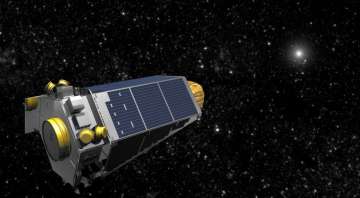Washington: Data from NASA’s Kepler spacecraft has enabled scientists to discover a treasure trove of over 100 planets outside the solar system, some of which have the possibility of hosting life.
Out of 197 initial planet candidates, scientists have confirmed 104 planets outside our solar system. Among the confirmed is a planetary system comprising four promising planets that could be rocky.
These four planets, all between 20 and 50 per cent larger than Earth by diameter, are orbiting the M dwarf star K2-72, found 181 light-years away in the direction of the Aquarius constellation.
The host star is less than half the size of the Sun and less bright. The planets' orbital periods range from five-and-a-half to 24 days, and two of them may experience irradiation levels from their star comparable to those on Earth.
Despite their tight orbits - closer than Mercury's orbit around our Sun - the possibility that life could arise on a planet around such a star cannot be ruled out, said lead author Ian Crossfield, from the University of Arizona.
The researchers achieved this extraordinary "roundup" of exoplanets by combining data with follow-up observations by Earth-based telescopes including the North Gemini telescope and the W M Keck Observatory in Hawaii, the Automated Planet Finder of the University of California Observatories, and the Large Binocular Telescope operated by the University of Arizona.
Both Kepler and its K2 mission discover new planets by measuring the subtle dip in a star's brightness caused by a planet passing in front of its star.
In its initial mission, Kepler surveyed just one patch of sky in the northern hemisphere, determining the frequency of planets whose size and temperature might be similar to Earth orbiting stars similar to our Sun.
In the spacecraft's extended mission in 2013, it lost its ability to precisely stare at its original target area, but a brilliant fix created a second life for the telescope that is proving scientifically fruitful.
After the fix, Kepler started its K2 mission, which has provided an ecliptic field of view with greater opportunities for Earth-based observatories in both the northern and southern hemispheres.
The K2 mission is entirely community-driven with all targets proposed by the scientific community.
Since it covers more of the sky, the K2 mission is capable of observing a larger fraction of cooler, smaller, red-dwarf type stars, and because such stars are much more common in the Milky Way than sun-like stars, nearby stars will predominantly be red dwarfs.
"An analogy would be to say that Kepler performed a demographic study, while the K2 mission focuses on the bright and nearby stars with different types of planets," said Crossfield.
The findings were published in the Astrophysical Journal.
(With PTI inputs)
Latest World News
